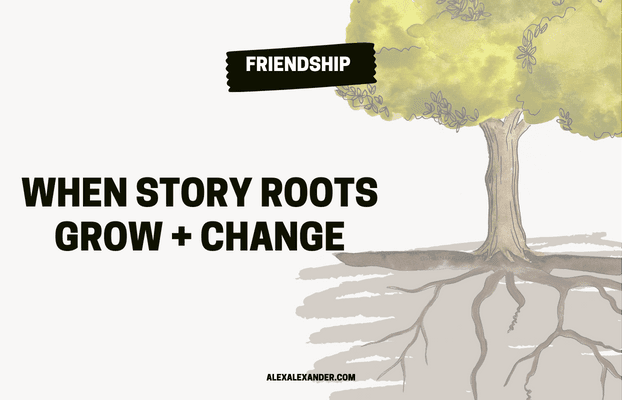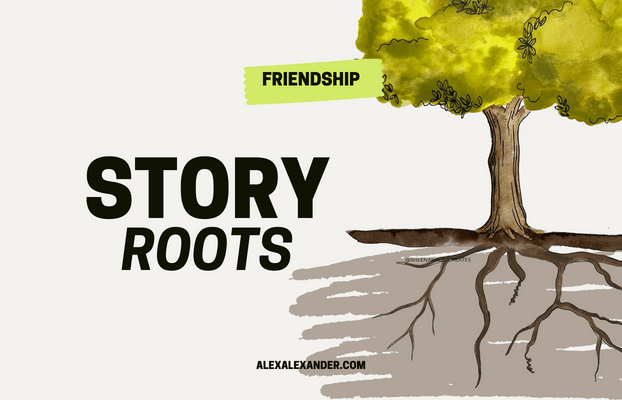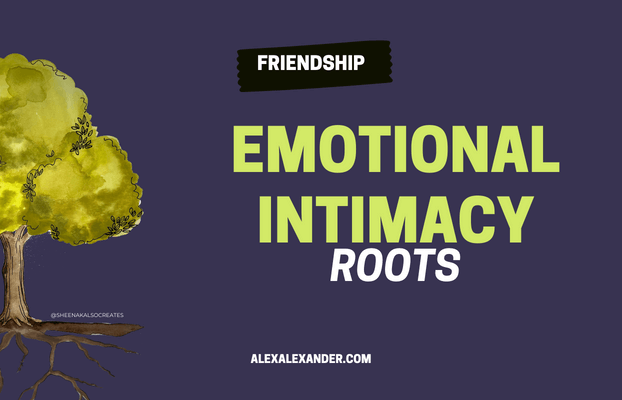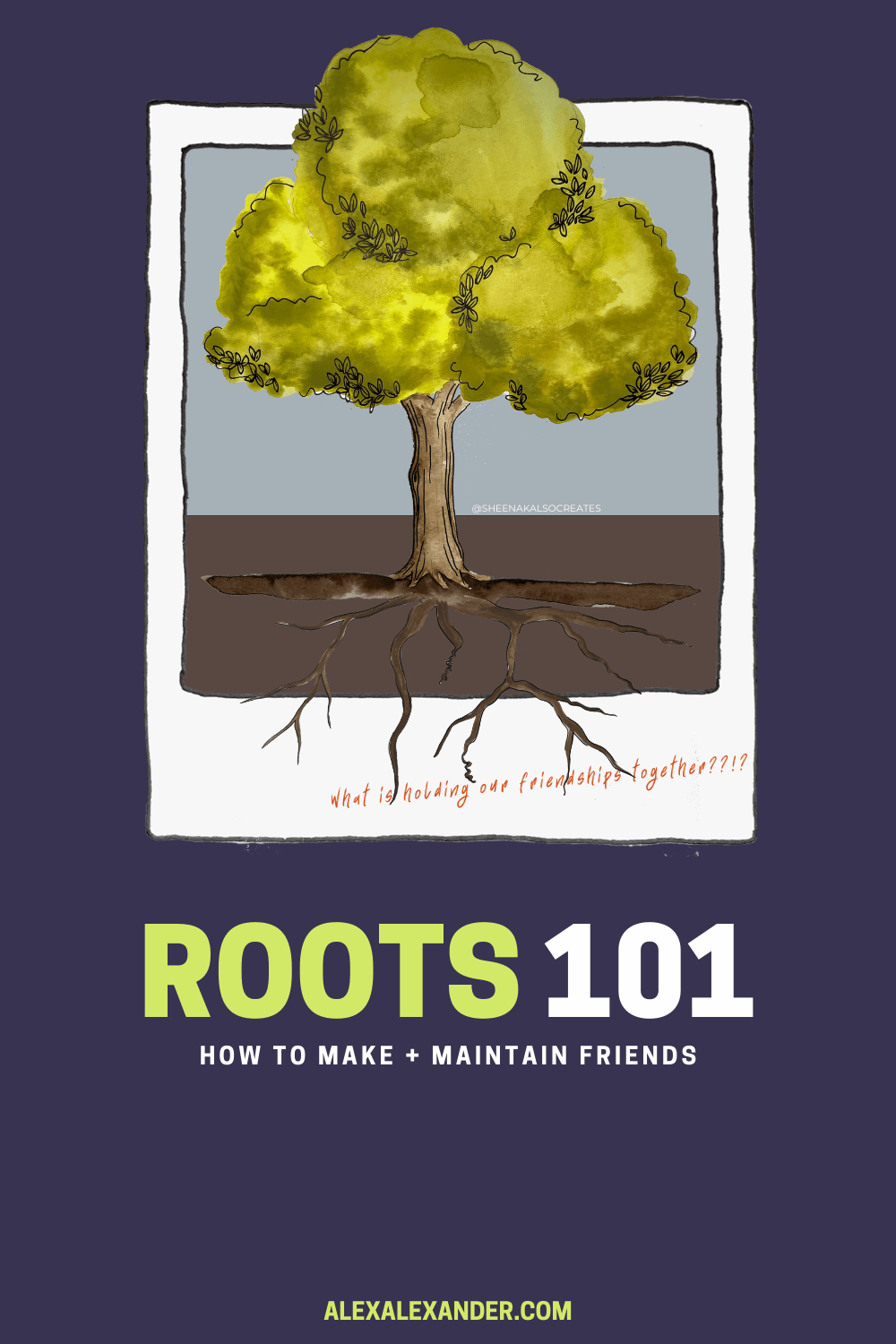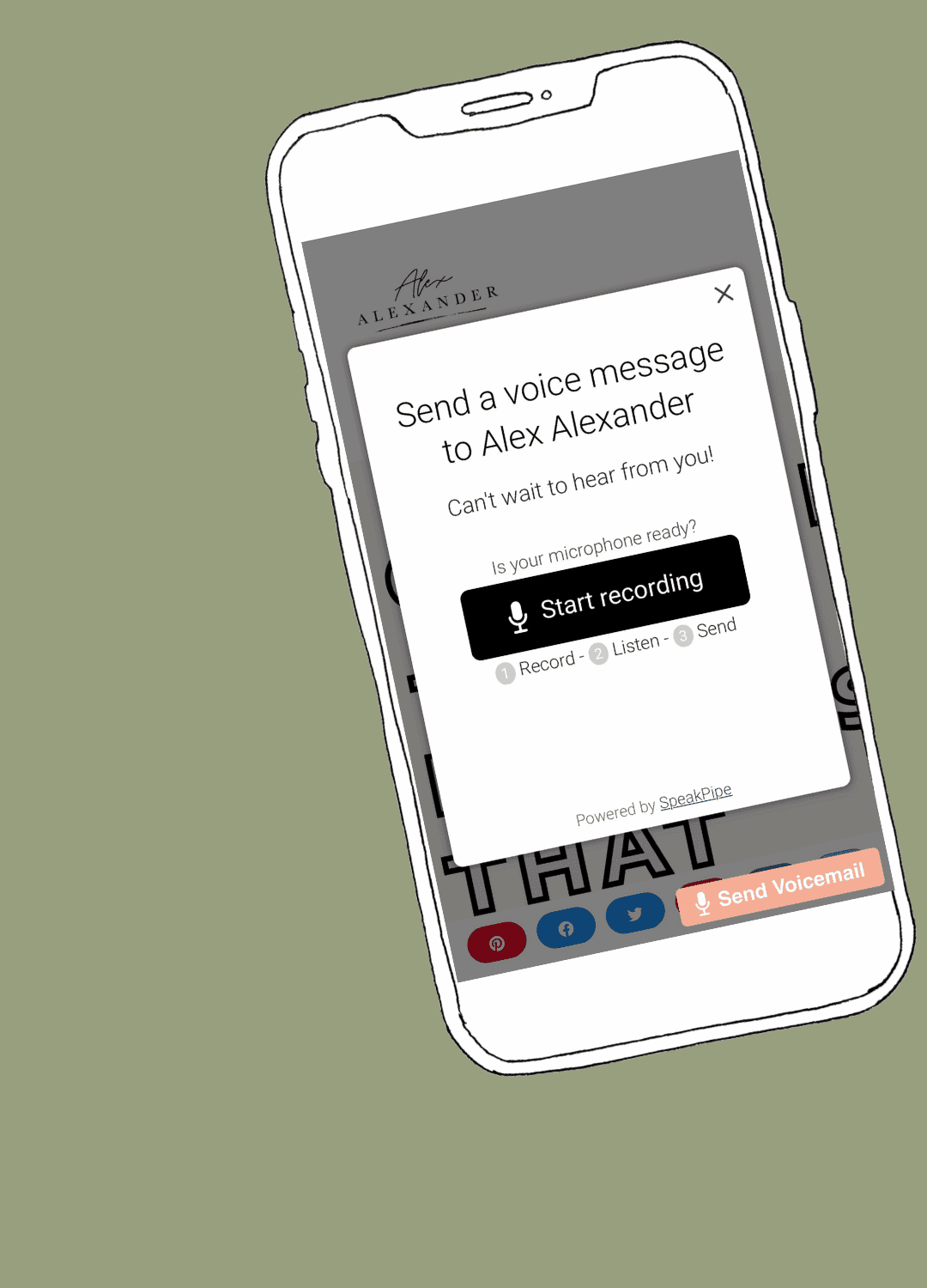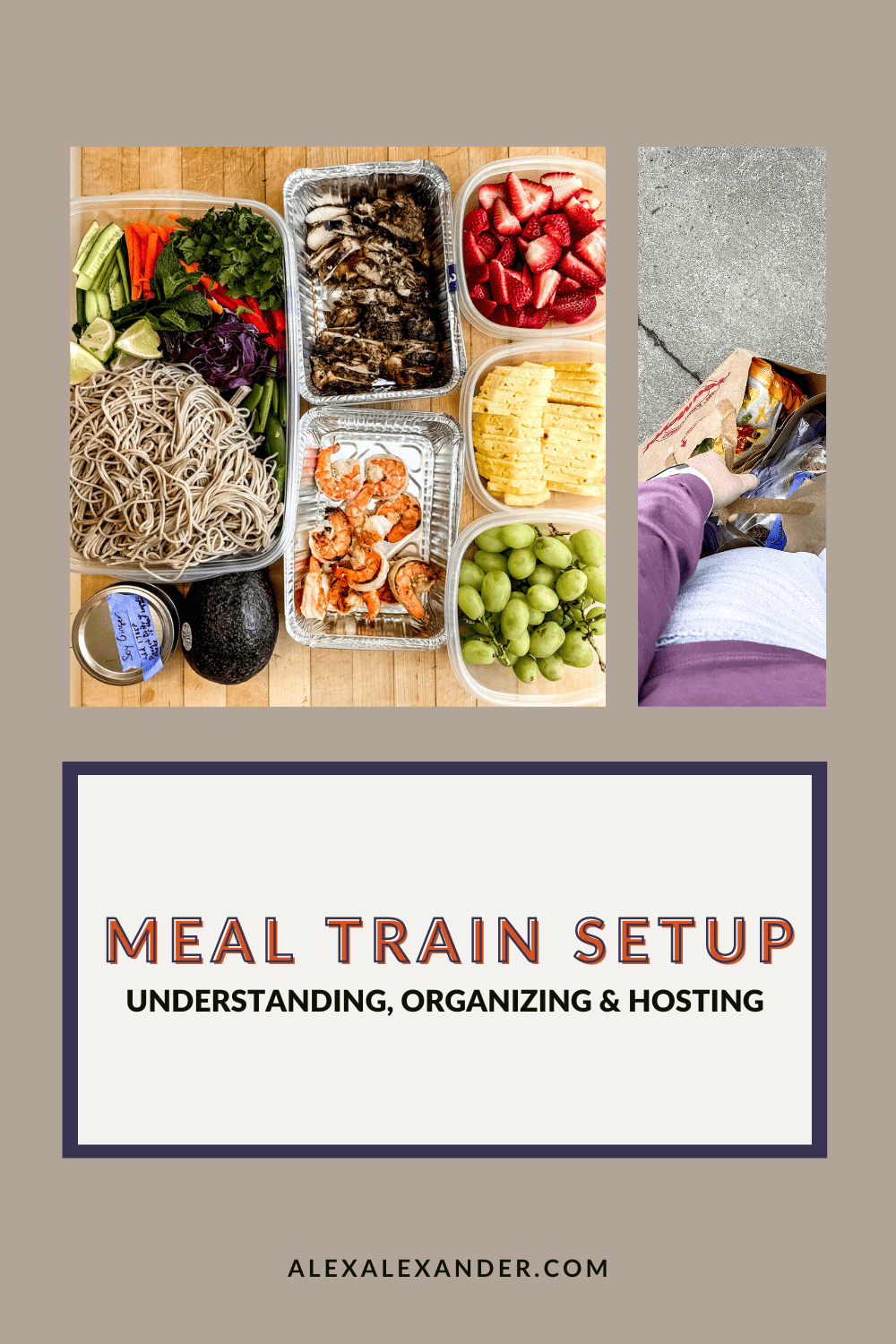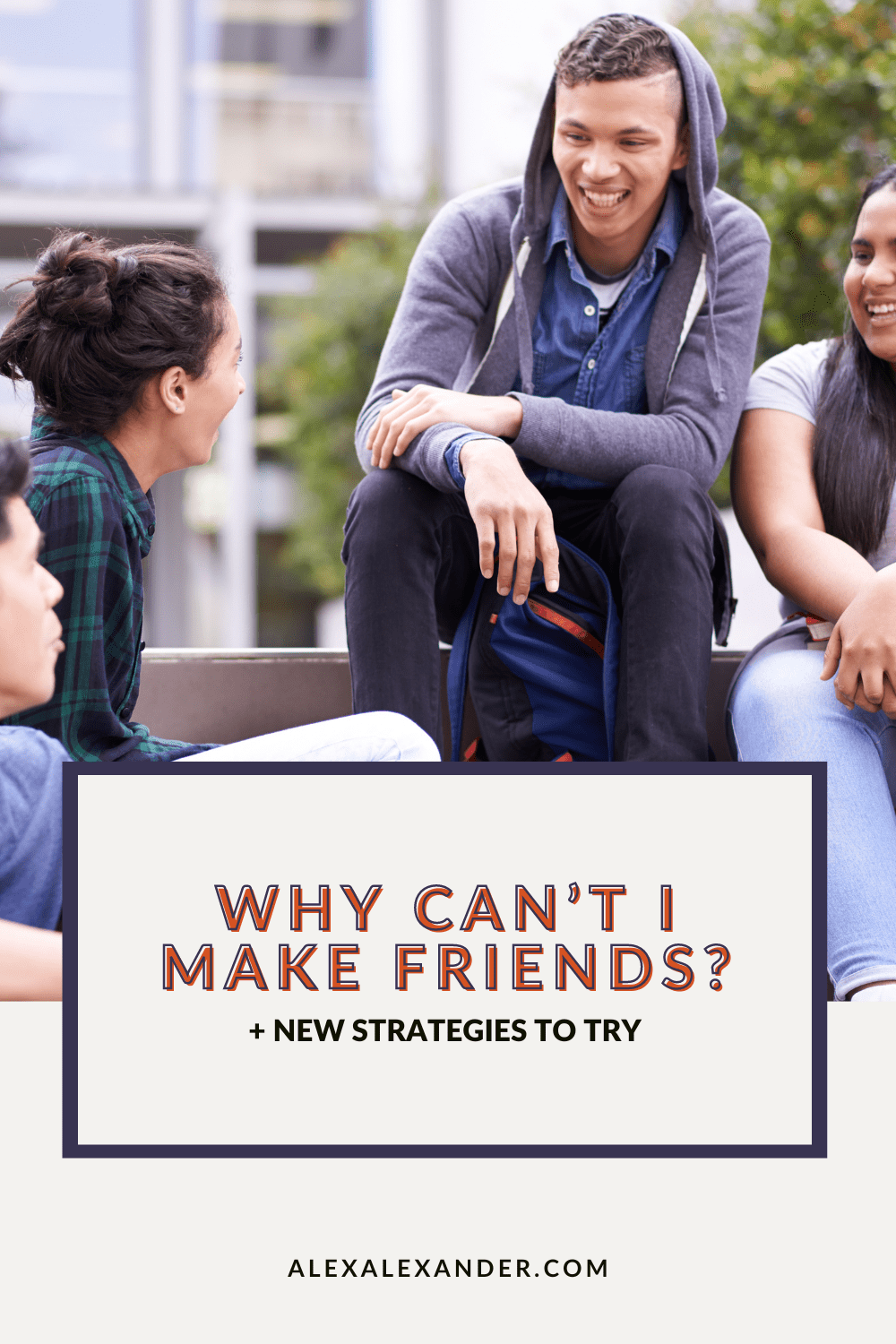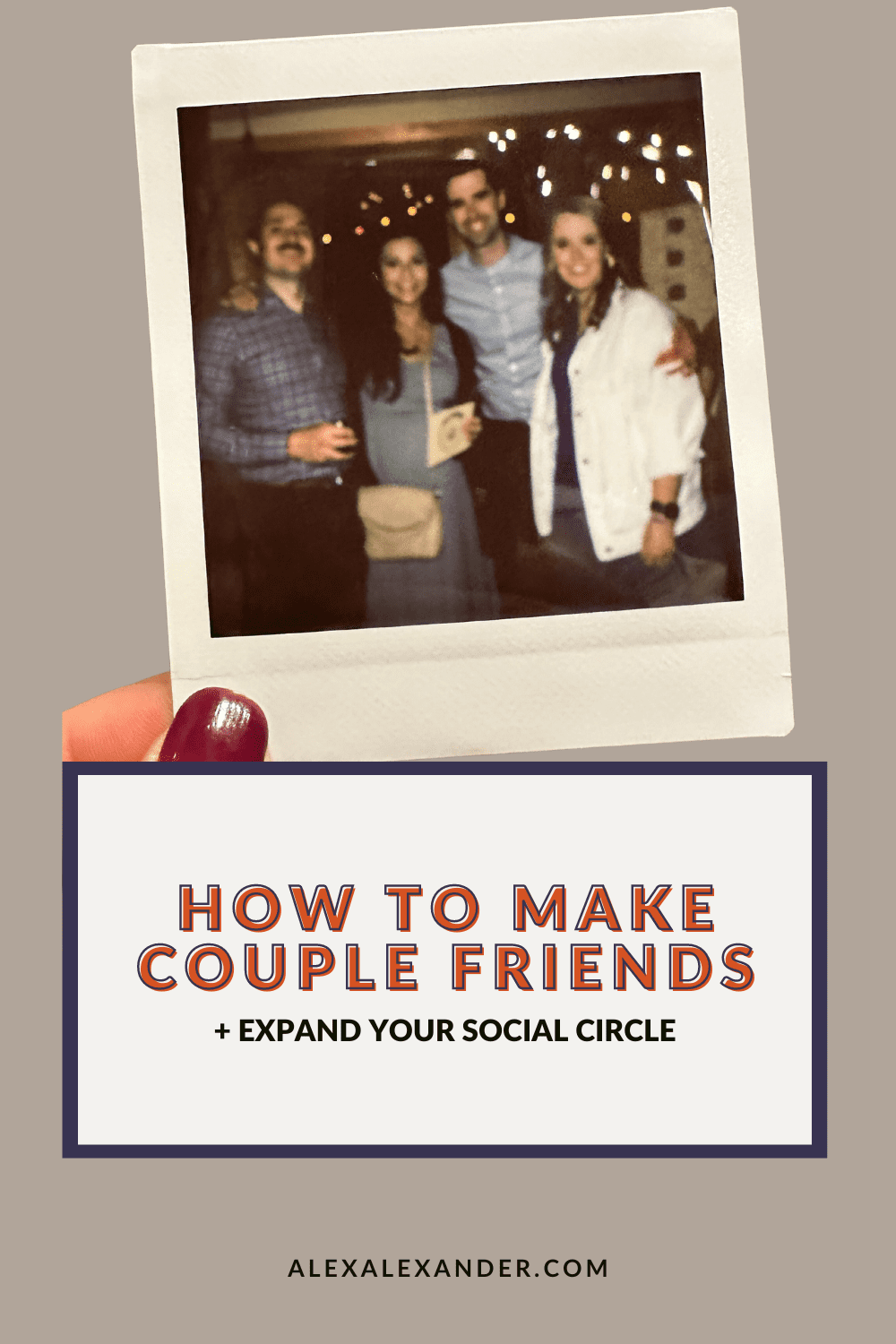
Close and supportive friendships have a strong system of roots holding them together. It’s not enough to create the roots, we need to act on them. Let’s talk about how to use your emotional intimacy roots to build and strengthen friendships.
Emotional intimacy roots are based in the past.
When you spend time with friends (shared experience/interest roots), you have the opportunity to learn new things about each other, create memories, find commonalities, and share in small + big intimacies.
You collect emotional intimacy roots over time – all the roots that build supportive friendships.
- Details you’ve noticed
- Memories you’ve made
- Shared/overlapping history
- Big + small intimacies
"Collected"
I use the word collected intentionally.
Moments are fleeting. Memories last.
You are in the moment with friends –
talking, laughing, telling a story, learning, dancing, singing, debating, relaxing
– and then the moment passes.
The details get tucked away.
The memories are stored.
The intimacies shared are appreciated.
And just like that, you are onto the next moment, left with the information you’ve filed away.
Collecting something requires attention.
There will be many details, moments, and memories that never become roots – you didn’t give them your attention, comprehend the information, or deem them important.
Let's say someone is a stamp collector.
Collections are built over time. They require dedication, energy, attention, and resources.
The collector has researched and sought each stamp they’ve added to their collection. The collection might have monetary value, but its real value to the collector is emotional. If the collector gifted the collection it wouldn’t hold the same emotional value:
The details about why each specific stamp was chosen.
The colorful stories about wild auction bidding wars.
The enthusiasm the collector felt when they stumbled upon a rare stamp at a bargain price.
The journey is likely just as important to the collector as the physical collection.
Supportive friendships are built on the little details we collect and use to affirm our friendships.
PODCAST EPISODE! I recorded an episode all about the three kinds of roots. Listen now!
the Types of emotional intimacy roots
SMALL DETAILS COLLECTED ABOUT A FRIEND
Their preferences, boundaries, experiences, perspectives.
- Knowing a friend loves donuts and surprising them with their favorite kind.
- Acknowledging a friend’s boundaries when you send an invite: “Hey! J is coming to dinner on Sunday. I know you normally take Sunday nights to yourself, but I just wanted to send you an invite in case you wanted to join.”
THE MEMORIES YOU’VE MADE TOGETHER.
You can have memories with old and new friends.
- A photo triggering a visceral memory for you + a friend – both of you are transported back to summer days ridding in that car you bought for $1,000 with all the windows down, music blaring.
- Reliving your high school football glory days with one of your oldest pals.
- Talking to a friend you met a few months ago – “Remember the day we met? I didn’t mean to snap. It had nothing to do with you. I was just having a bad day.”
SHARED HISTORY
You’ll discover shared history with new friends and might even uncover new facts with lasting friendships.
- Texting a friend – “My high school soccer team made the state finals!” You both played in high school, but didn’t play together at the same time.
- “Wait! You know S too?!” You share a mutual friend, but one knows her from work, the other from High School.
SMALL INTIMACIES
Subtle ways we let someone in – Sharing a win, acting carefree, letting someone help us with something small, telling a friend you enjoyed your time together, and many more.
- Sharing the news about your promotion!
- Even though you don’t have many dancing skills, laughing with total disregard and letting loose on the dancefloor.
BIG INTIMACIES
Trusting someone with our more vulnerable conversations, requests, and support needs. Sharing a secret, asking for help, calling in an emergency, telling a friend we’ve gone back to therapy, talking about a big problem, sharing that we’ve been struggling with our mental health, and many more.
- Checking in on a friend on the anniversary of a traumatic event with a text that says, “Hey! I know you might want to be alone today, but I am thinking of you” to make sure he knows their is a supportive friend available if he needs one.
- A friend asks, “Will you be my child’s emergency contact with school? That would mean if they get ahold of me, you might need to go pick the up in an emergency. Knowing there is a backup would save me a lot of stress.”
BTW – Everyone’s definition of a small vs. big intimacy will be different. We’ll dive deeper into finding your big vs. small intimacies another time.

CAN I ADD YOU TO THE GROUP CHAT?
DON'T MISS AN UPDATE - SIGNUP FOR OUR WEEKLY NEWSLETTER.
You’ll get the full scoop on everything we’ve been up to in the last seven days – podcast episodes, blog posts, and updates, plus an exclusive note from Alex every week with her latest, unedited thoughts.
GROWING INITIAL EMOTIONAL INTIMACY ROOTS
Let’s use a close friend from high school as our example.
[Another example in my Roots 101 Post]
Your close friend from High School – Back in the day, you spent all sorts of time together. There was a big variety in ways you spent time together, a broad range of topics you talked about, and a closeness that comes from being friends during the time in life when you are learning, making mistakes, and trying new things.
Very few, if any, fellow classmates have the plethora of memories and connection points this friend has.
The variety of emotional intimacy roots supporting this friendship:
- Their favorite color is blue.
- Their first car was a jeep.
- Their favorite dessert is a chocolate cupcake.
– Details you noticed and tucked away about your friend.
- You have vivid memories of cheering together at football games.
- You can picture the outfits you planned out for weeks for spirit week.
- You remember the terrible haircut they got senior year – was that after winter break?
Nowadays, you laugh about all the times you got in trouble with your parents for breaking a curfew. It wasn’t so funny back then.
– All memories you share.
- You took Spanish, and your friend took French. Even though you didn’t take the same class, you’d recognize their French professor if you saw them out and about.
- Your parents both volunteered at the local food bank. Even though you never volunteered, you still have some basic familiarity with their stories and the ways this gave back to the community.
– All shared/overlapping history.
- Your friend leaned on you in High School when things weren’t going well with their parents.
- You remember comforting your friend after her grandmother passed away.
– You shared in some big intimacies.
- You both spent endless hours doing…. Nothing. Laying around in your PJs.
- You went with each other to big family reunions.
- You acted silly – all the time – parking lot dance parties, showing up at school in ridiculous outfits, singing randomly in the halls, rolling down the windows, and singing at the top of your lungs in the car.
– All small intimacies (at least in my book).
This friendship’s “we’ve been friends since high school” root is STRONG, and this is only a fraction of the roots.
Emotional intimacy roots transport both of us back to past versions of ourselves.
Emotional intimacy roots give us connection points with friends. If you called each other to catch up, but it’s been a long time there are still lots of emotional intimacy roots you can depend on to guide your conversation.
-
- “Are you still driving the jeep?”
- “You’ll never guess who I ran into – the french teacher you had in high school. What was her name again?”
- “How are your parents? Is your grandpa still living in the bay area?”
- “Oh my gosh – Do you remember when we went wild for crazy hair day? I had glitter in my hair for months.”
You can mix emotional intimacy roots from decades ago with new emotional intimacy roots in your conversations and actions.
-
- “I am so excited you got that promotion! Can you imagine telling your 16-year-old self that you now work in engineering?! You hated math class.”
- “I know you don’t eat many sweets anymore, but would you be interested in a chocolate cupcake?
- “You’re getting a new car! How will it beat the jeep? I know the jeep broke down all the time, but nothing will beat blasting music and driving around town in that car.”
Emotional intimacy roots often where we look to make our friendships comfortable and in act in ways that show this is a supportive friendship.
However, we change and therefore roots die or wither – which can be uncomfortable.
Emotional Intimacy Roots create supportive friendships.
We collect all this information and tuck it away.
It’s not enough to just store the information – you have to use the information to affirm having supportive friendships.
My next post about story roots will dive deeper into using your emotional intimacy roots to strengthen friendships and build up our social support.
PODCAST EPISODE! ” How to Make Friends as. Grown-Up.” Listen now!
Emotional Intimacy Roots keep us connected
Roots hold our friendships together.
Emotional intimacy roots hold our friendships together by prompting us to initiate contact and giving us connection points to keep our time together comfortable.
- “Remember when we both broke our legs at that swim meet? I tried to retell the story – must be one of those stories where you had to be there.”
- “Thinking of you! Losing your job is so hard. Here if you need to talk.”
- “I just ate the best chocolate cupcake! Made me think of you.”
I hear this all the time:
- “I want close friendships.”
- “Where do I find friends I can talk to about anything?”
- “How do I find friends I can do anything with?”
- “I want a tight-knit social circle.”
Those close and supportive friendships exist because of the web of roots you have built. We can’t show up for our friends in meaningful ways if we haven’t paid attention to what is meaningful to them.
There’s a lot of focus on the end goal – finding close friends.
But our oldest, closest friends – we are fondest of them because of our journey together.
When it comes to new friends – don’t cheat yourself out of the journey – the messy, funny, hilarious moments are the best memories and the details that bring us close. You can build that with new friends at any age.
Curious how to keep a friendship strong? Read about the other types of roots.
